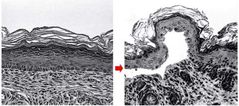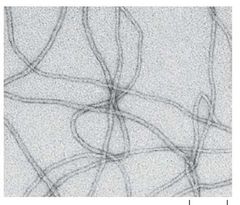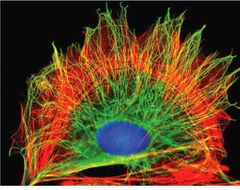![]()
![]()
![]()
Use LEFT and RIGHT arrow keys to navigate between flashcards;
Use UP and DOWN arrow keys to flip the card;
H to show hint;
A reads text to speech;
24 Cards in this Set
- Front
- Back
|
What is the cytoskeleton? |
It is what defines the size and shape of cells. It also provides support/strength. It is made up of three components: 1. Intermediate filaments 2. Microtubules 3. Actin filaments |
|
|
Where can you find intermediate filaments (IFs)? |
They underlie the nuclei and crisscross throughout the cell. |
|
|
Of the three types of filaments, which is the strongest and most flexible? |
Intermediate filaments |
|
|
Why are IFs analogous to a rope? |
Their strength and flexibility comes from the many thin parallel strands that make them rope like. Unlike a rope, they are also very stretchable. |
|
|
What is the primary building block of IFs? What are its 3 domains? |
Intermediate filament proteins. They have a head and tail section at the ends. In the middle is the central rod domain, which forms one long linear alpha helix motif. No high energy nucleotide required for assembly of IF, unlike other cytoskeleton filaments. |
|
|
How are IFs assembled? |
1. The alpha helical monomers form coiled coil dimers. 2. Two coiled coil dimers form a staggered tetramer. This is the fundamental IF subunit/building block. 3. 8 Tetramers come together to form a Unit Length Filament (ULF) 4. ULFs come together to make intermediate filaments |
|
|
What is the benefit of the coiled coil motif? |
It is two alpha helices wrapped around each other, which provides strength to the IFs. |
|
|
Why are the tetramer subunits of IFs staggered? |
The staggered ends allows for further assembly. |
|
|
Do IFs have polarity? |
No because they are symmetric. |
|
|
What happens to IFs at low levels of stress? |
They stretch because the alpha helices can stretch. H bonds sever. |
|
|
What happens to IFs at high levels of stress? |
Dimers slide passed one another in each tetramer. |
|
|
What is the benefit of the interactions between IF dimers, tetramers, and ULFs being relatively weak/unstable? |
This allows the IFs to deform in order to handle stress. |
|
|
What are the cytoplasmic intermediate filaments? What types of cells are they found in? |
Desmin filaments: Muscle cells Keratin filaments: Epithelial cells Vitamin/vitamin-related filaments: Connective tissue cells, muscle cells, and glial cells Neurofilaments: Nerve cells Note: there are approx. 50 different keratins in humans. Different keratins in different tissues. |
|
|
What are the nuclear intermediate filaments? |
Nuclear lamins: in all animal cells |
|
|
What is the nuclear lamina? |
A mesh of lamin proteins that support the nuclear envelope (lipids), giving shape and strength to nuclei. |
|
|
What is different about nuclear lamins compared to cytoplasmic IFs? |
Nuclear lamins completely disassemble during mitosis in each cell cycle, as a result of phosphorylation, then reassemble in interphase as a result of dephosphorylation. |
|
|
What disease is an example caused by a defective nuclear lamin gene? |
Progeria (children exhibit symptoms of aging). |
|
|
What are desmosomes? |
Contact points between cells that "lock" them together. They are protein structures that radiate IFs out from both adjacent cells, linking the IF cytoskeleton in neighboring cells. This forms a network extending through many cells. Cell to cell junctions that anchor IFs to the plasma membrane. |
|
|
What is EBS? What causes it? |
Epidermolysis bullosa simplex. It is an inherited genetic defect in keratin or keratin-associated proteins.
Symptoms include blistering of skin with mild or no physical trauma, particularly on extremities. Severity depends on which of the 21 skin keratins contains defect as well as position of mutation on the gene. Mutant protein integrated into keratin IF network renders it susceptible to collapse. |
|

What is this an image of? |
Left is a TEM of normal epidermis. Right is a TEM of an EBS dermis. |
|

What is this an image of? |
Intimidate filament Unit Length Filament |
|

What is this an image of? |
The nuclear lamina mesh. |
|

What is this an image of? |
Florescent microscopy image showing microtubules in green and actin in red. |
|
|
What is plectin? |
It is an accessory protein that cross links intermediate filaments into bundles and link them to MTs, AFs, and to adhesive structures in the desmosomes. Provides IF stability. |

